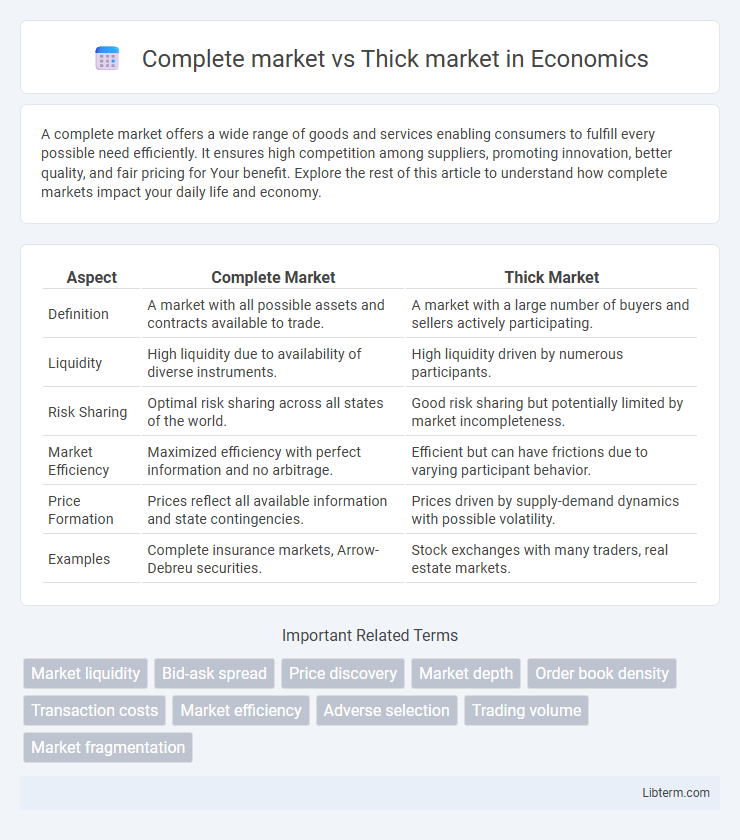A complete market offers a wide range of goods and services enabling consumers to fulfill every possible need efficiently. It ensures high competition among suppliers, promoting innovation, better quality, and fair pricing for Your benefit. Explore the rest of this article to understand how complete markets impact your daily life and economy.
Table of Comparison
| Aspect | Complete Market | Thick Market |
|---|---|---|
| Definition | A market with all possible assets and contracts available to trade. | A market with a large number of buyers and sellers actively participating. |
| Liquidity | High liquidity due to availability of diverse instruments. | High liquidity driven by numerous participants. |
| Risk Sharing | Optimal risk sharing across all states of the world. | Good risk sharing but potentially limited by market incompleteness. |
| Market Efficiency | Maximized efficiency with perfect information and no arbitrage. | Efficient but can have frictions due to varying participant behavior. |
| Price Formation | Prices reflect all available information and state contingencies. | Prices driven by supply-demand dynamics with possible volatility. |
| Examples | Complete insurance markets, Arrow-Debreu securities. | Stock exchanges with many traders, real estate markets. |
Understanding Market Completeness: An Overview
Market completeness refers to a financial market's ability to allow all contingent claims to be traded, ensuring every possible payoff can be replicated through available securities. A complete market provides optimal risk-sharing and hedging opportunities, while a thick market, characterized by high liquidity and many participants, may not guarantee completeness if certain risks remain unspanned. Understanding this distinction is crucial for pricing derivatives accurately and designing efficient portfolios in financial economics.
Defining Complete Markets
Complete markets are defined by the availability of a full set of assets or securities that allow agents to perfectly hedge against all possible future states of the world, enabling efficient risk-sharing and optimal allocation of resources. In contrast, thick markets refer to environments with many participants and high liquidity, but they may still lack the comprehensive set of contingencies needed for a market to be considered complete. The concept of complete markets plays a crucial role in financial economics, underpinning the theoretical foundation for asset pricing models and equilibrium analysis.
Characteristics of Thick Markets
Thick markets exhibit high liquidity with numerous buyers and sellers, resulting in narrow bid-ask spreads and efficient price discovery. These markets facilitate quick execution of large orders without significant price impact due to abundant trading volume and active participation. Examples include major stock exchanges like the New York Stock Exchange and NASDAQ, known for their deep order books and diverse market participants.
Key Differences: Complete Market vs Thick Market
Complete markets feature a full set of contingent claims allowing every possible future state to be hedged or traded, ensuring perfect risk-sharing among participants. Thick markets exhibit high liquidity and numerous active traders, enabling efficient price discovery and low transaction costs, but may not guarantee the existence of all contingent claims. The key difference lies in completeness of financial instruments versus market liquidity and participation levels.
Benefits of Operating in a Complete Market
Operating in a complete market provides investors with the ability to hedge or trade any contingent claim, ensuring optimal risk-sharing and portfolio diversification opportunities. Complete markets facilitate price discovery and liquidity, allowing for more efficient allocation of resources and reducing transaction costs. This environment enhances financial stability by enabling participants to fully insure against uncertainties and tailor investment strategies to their risk preferences.
Advantages of Thick Markets for Participants
Thick markets offer higher liquidity, enabling participants to execute large trades quickly without significantly affecting prices, which reduces transaction costs. The increased number of buyers and sellers enhances price discovery, leading to more accurate and efficient market valuations. Participants benefit from tighter bid-ask spreads, greater market depth, and improved opportunities for arbitrage and risk management in thick markets.
Challenges Associated with Complete Markets
Complete markets, characterized by the existence of a full set of contingent claims for every possible state of the world, face significant challenges including informational inefficiencies, regulatory complexities, and high transaction costs. The difficulty in achieving perfect risk-sharing arises due to issues such as asymmetric information, market frictions, and the impracticality of creating securities for every conceivable future event. These challenges contrast with thick markets, which, while potentially incomplete, benefit from higher liquidity and lower barriers to entry, facilitating more efficient price discovery and trading activities.
Limitations of Thick Markets
Thick markets, characterized by high liquidity and numerous buyers and sellers, offer efficient price discovery but face limitations such as reduced market depth during extreme volatility and increased competition leading to potential price manipulation. These markets can suffer from informational asymmetries despite their size, resulting in suboptimal trading outcomes for less informed participants. Unlike complete markets that theoretically allow for perfect risk sharing and all contingent claims trading, thick markets often fall short in achieving full market completeness due to transaction costs and regulatory constraints.
Impact on Pricing and Liquidity
Complete markets offer a wide range of financial instruments, enabling efficient risk sharing and more accurate pricing through better information aggregation. Thick markets feature high trading volumes and many participants, which enhance liquidity by facilitating quicker transactions and tighter bid-ask spreads. The combination of completeness and thickness in a market leads to more stable prices and increased market depth, reducing transaction costs and improving overall market efficiency.
Practical Examples: Comparing Complete and Thick Markets
Complete markets feature a full set of financial instruments that allow individuals to hedge against every conceivable risk, such as contracts for all future states of the world, exemplified by government bond markets offering state-contingent claims. Thick markets, like the New York Stock Exchange, have high liquidity and numerous participants but may lack some state-contingent contracts, limiting risk diversification. Practical comparisons show that while complete markets provide optimal risk-sharing solutions theoretically, real-world thick markets prioritize transaction volume and liquidity, often falling short of market completeness due to missing assets and information asymmetries.
Complete market Infographic

 libterm.com
libterm.com